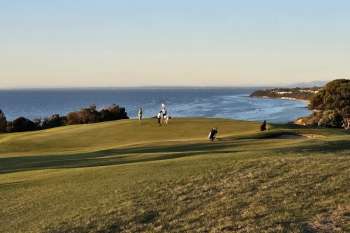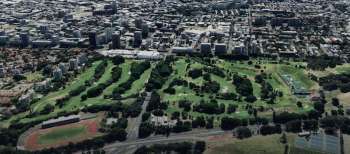Back when the Australian Golf Digest was first published, in November 1970, Australia’s population was around 12.5 million and our best golf courses were almost exclusively those built during the ‘Golden Age’ of the 1920s and 30s. Much has changed in the ensuing 40 years, and there is no doubt that as we look forward to 2050 there are grave challenges facing both our industry and the nation at large.
One of the more pertinent discussion points during our recent federal election campaign centred on population growth, and the difference between ex-Prime Minister Rudd’s push for a Big Australia, and his successor Julia Gillard’s belief in a Sustainable one. Gillard clearly used the issue to score political points in marginal electorates, but there does remain sentiment in the wider community that hurtling toward the Treasury Department’s projection of 36 million by 2050 might be a little reckless. Regardless of the final figure, clearly in the next 40 years our population will continue to grow, and housing density in our capital cities will continue to increase.
So what does this mean for golf, and how might the game change and adapt in the decades ahead? Well, the first thing that all of us in this industry need to accept is that growing golf in the future is not going to get any easier. For a start, in one painful decade our great game has gone from a mainstream sport to one that ranks alongside surfing and netball in terms of media exposure. To redress this apparent imbalance golf needs more free-to-air television coverage. It also needs genuine home-grown superstars.
Perhaps even more concerning, however, are supply and participation issues currently facing golf in our major metropolitan areas. In recent years we have seen a number of established city clubs selling up their land and moving to the suburban outskirts, and this is a trend sure to continue as real estate prices rise. No matter which way you look at it, more people living in metropolitan areas but with fewer golf courses available to play cannot be good for the growth of the game. Equally worrying are recent statistics produced by the Australian Sports Commission regarding junior participation, which highlighted a near 20% drop in the under 24s age group over the past few years. We clearly have serious problems here.
In terms of golf courses and golf design, many have suggested that the future for an increasingly time-poor population will be more 9-hole courses and more 9-hole competitions. While less golf is naturally a better outcome than no golf at all, surely we would be better advised to retain the integrity of the 18-hole round and instead look at ways of making the game quicker, easier and more accessible to newcomers. This doesn’t mean building pitch-and-putt courses, but rather layouts that flow easily from green to tee, are free from unnecessary or overly penal hazards and emphasise fun and memorability over length and difficulty.
Forty years is a long time, but most observers would agree that there are likely to be fewer sandy coastal sites made available for development in the years ahead, and that unless participation rates improve the market for new course design will be somewhat limited. In terms of quality golf, the last twenty years have been incredibly prolific with each of The National (Moonah, Ocean and Old), Ellerston, Barnbougle Dunes, Lost Farm, The Dunes, Moonah Links (Legends and Open), Kennedy Bay, St Andrews Beach, Thirteenth Beach, Magenta Shores, Brookwater and The Cut sitting comfortably within Australia's top 40 courses. Throw in redeveloped clubs like The Lakes, Royal Queensland and Peninsula and you quickly appreciate just how golden this modern era has been for design.
We might yet get another couple of courses along the Tasmanian coastline, some more golf on the Mornington Peninsula and hopefully something out of the vast West Australian dunes, but otherwise development looks set to continue away from the sea and on mostly uninviting sites. Demographic projections show that our population will keep getting older so golf estates should remain popular, and architects working here will continue to find their courses being used to help sell housing. What’s interesting to consider, is how such layouts might be arranged in the future. Do we really need five sets of tee boxes, forced water carries and ‘championship length’ holes on courses played primarily by aged or aging residents?
Despite the success of many golf estates across Australia, the truth is that most developers lose money on the actual golf course and once completed they are desperate to hand over its maintenance and operation to either members, homeowners or a golf management company. If the private membership model continues to struggle and golf participation remains stagnant, then some future developments that might have included golf will instead seek less expensive uses for their green open space. Those developers who do persist with golf are likely to look at ways of controlling their initial investment in the course as well as managing their ongoing operational costs. The best and easiest way to do this is by building sensible golf courses.
There is nothing wrong with sub-6,000 metre golf, especially given that most new layouts will never host major professional championships. Courses that are shorter and walkable are also less expensive to build and have reduced areas of maintainable fairway and less of their acreage dedicated to golf. Rounds are also quicker, and in any demographic a four-hour game has far greater appeal than something that takes five-hours or more.
The same formula should apply for established city clubs relocating. Such clubs need to be careful to avoid creating expensive white elephants, and ensure they build courses that are appropriate to both their present and future memberships. Ideally the aim should be to establish a facility that can not only serve the needs of their members, but also act to encourage fringe dwelling newcomers into our game.
Of course, the great unknown in terms of the future for golf course design remains technology and whether continued equipment advances will place even greater pressures on existing clubs and new course developers. There is simply no need for players to be able to hit the ball 350 metres, and the sooner golf’s regulators wake up to the damage done to our game and roll back the golf ball, and reduce the size of the driver head, the better. Regardless of what the game’s governing bodies do with equipment, it’s clear that the industry here in Australia needs to focus on ways of attracting and retaining new golfers, and the reality will hit home eventually that making courses longer, harder and more expensive is not the answer.
If the past twenty years of design in Australia have taught us anything, it’s that the foundation of great golf courses are great golf holes (see table below), and existing clubs looking to improve their courses should be focused more on building fun holes than squeezing every last metre out of their property. Many clubs have already run out of room to extend any further, and these clubs are best advised to ignore the demands placed upon their layouts by the long-hitting bombers, and instead focus on what might work for the vast majority who play our fascinating game. The golf experience in Australia would improve drastically if we could reduce playing times, but this isn’t possible while existing golf clubs assume that improving their holes means making them longer and more difficult.
So in terms of the future, and how golf in Australia in 2050 might look, much depends on how the industry handles the very real challenges currently facing us, and whether the golfing public is happy to keep paying top dollar to get beaten up by demanding courses. For golf course architects the future is equally unclear, as they are all reliant upon the game raising its profile and attracting new players as well as golf real estate continuing to sell and second-tier metropolitan clubs continuing to move into the suburban fringes.
There are some talented designers in this country, but it’s hard to know when or where the next Barnbougle Dunes or National Golf Club will appear, and unlikely that all of the present architects will be still working in the business in the decades ahead. Indeed, about the only golfing certainty is that in forty years time we will all look back on this current era as the most golden in our glorious history.
Darius Oliver, Architecture Editor
Best 18 holes in Australia (post 1970).
In recognition of the quality of modern golf courses in Australia, we’ve come up with a Fantasy 18 made up of holes built during the past 40 years. The rules were simple, only one hole per course was allowed and it didn’t matter in what order the holes appear. We did try to keep them as close to their regular sequence as possible, and stuck to a 36-36 Par 72 formula for the finished layout.
Hole Par Selection
1st 5 The National (Ocean) 1
2nd 3 Peninsula (North) 2
3rd 4 Royal Queensland 3
4th 5 Joondalup (Quarry) 4
5th 4 Lost Farm 5
6th 4 Laguna Whitsundays 5
7th 3 The National (Old) 7
8th 4 The National (Moonah) 3
9th 4 RACV Healesville Country Club 18
10th 4 Pelican Waters 2
11th 5 The Lakes 11
12th 4 The Cut 12
13th 4 Barnbougle Dunes 4
14th 3 Hyatt Coolum 11
15th 4 St Andrews Beach 2
16th 4 Ellerston 16
17th 3 The Dunes 17
18th 5 The Heritage (St John) 9




